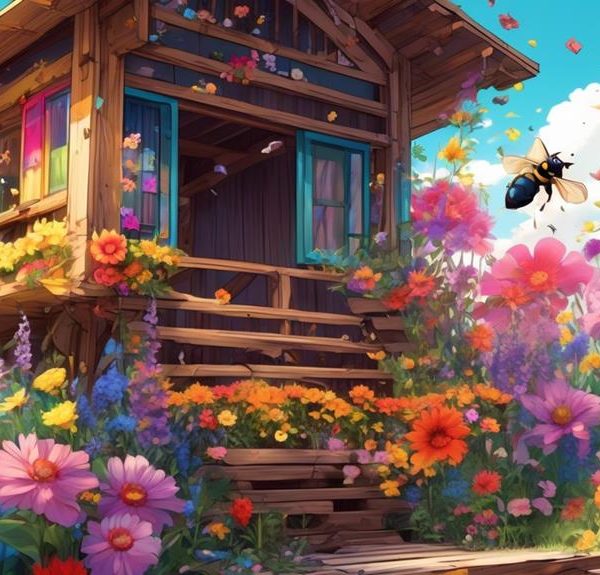Immerse yourself in the fascinating world of carpenter and bumblebees, and discover why their striking similarities belie crucial differences.
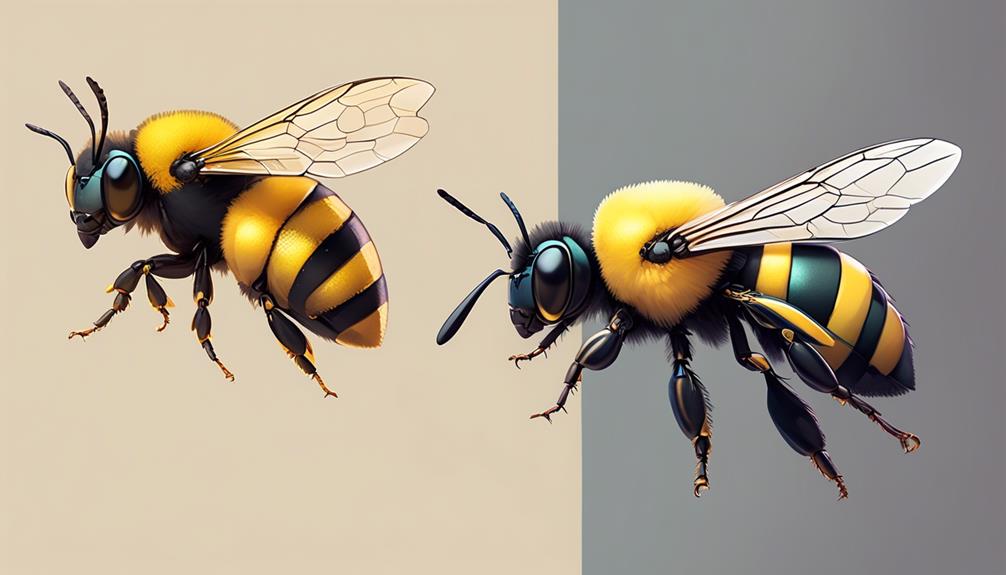
Do Carpenter Bees Look Like Bumblebees
In the buzzing world of bees, the solitary carpenter bee and the social bumblebee stand as paradoxical figures, both captivating your interest with their striking similarities. You've likely seen both in your garden, each buzzing from flower to flower, their fuzzy bodies and black and yellow coloration making it difficult to distinguish one from the other.
But are these bees as identical as they seem on the surface? I invite you to join me as we explore the nuances between carpenter bees and bumblebees, uncovering the intriguing details that set them apart and why it matters to you.
Key Takeaways
- Carpenter bees and bumblebees have distinct physical differences, such as the appearance of their abdomens, body hair, and color patterns.
- Carpenter bees are solitary insects that bore into wood to build nests, while bumblebees are social insects that live in colonies, often nesting underground.
- Carpenter bees can potentially damage wooden structures, while bumblebees play a crucial role in pollination and plant growth.
- Both carpenter bees and bumblebees are attracted to flowers, but bumblebees have a higher level of pollination and are more resistant to insecticides compared to carpenter bees.
Identifying Carpenter Bees

While they may bear a striking resemblance to bumblebees, you can identify carpenter bees by their shiny, hairless, black abdomens and their habit of boring into wood to build nests. You'll see these insects hovering around your home, deck, or garden structures, particularly those made of untreated wood. Unlike bumblebees, carpenter bees are solitary creatures. Each female bee digs an individual tunnel into wood to lay her eggs.
Beyond the physical characteristics, you can identify carpenter bees by their behaviors. Unlike bumblebees, they're not social insects. They won't form colonies or hives. Instead, each female bee claims her own little piece of wood, boring a hole and creating a nest.
These nests have a very distinctive appearance. You'll notice a nearly perfect half-inch diameter hole, usually in untreated wood. The female bee will tunnel in a few inches, then turn and bore along the grain of the wood for several more inches. This forms the main corridor of the nest, off of which she'll lay her eggs in individual cells.
Recognizing Bumblebees
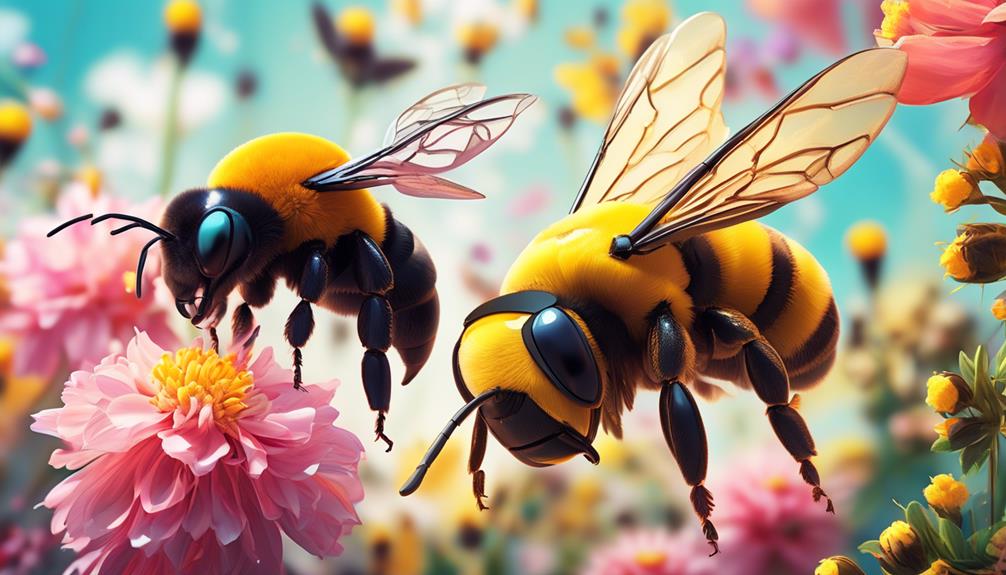
On the flip side, distinguishing bumblebees from their carpenter counterparts involves noting some key differences in appearance and behavior.
Bumblebees have a robust, hairy appearance, often with bands of black and yellow or orange across their bodies. Their bodies are typically more rounded, and they're larger than most other bees, measuring up to an inch long.
You'll also notice that bumblebees have a pollen basket on their hind legs. That's a smooth, concave surface surrounded by hair, and it's where they store pollen to bring back to the colony. Carpenter bees, on the other hand, don't have these baskets.
Behaviorally, bumblebees are social insects that live in colonies, often nesting in the ground or in dense grass clumps. If you're observing a bee entering a hole in a wood structure, it's likely a carpenter bee, not a bumblebee.
Additionally, bumblebees aren't as aggressive as carpenter bees. Unless disturbed, they're unlikely to sting. They are, however, critical pollinators and play a crucial role in our ecosystem.
Physical Differences Between Species
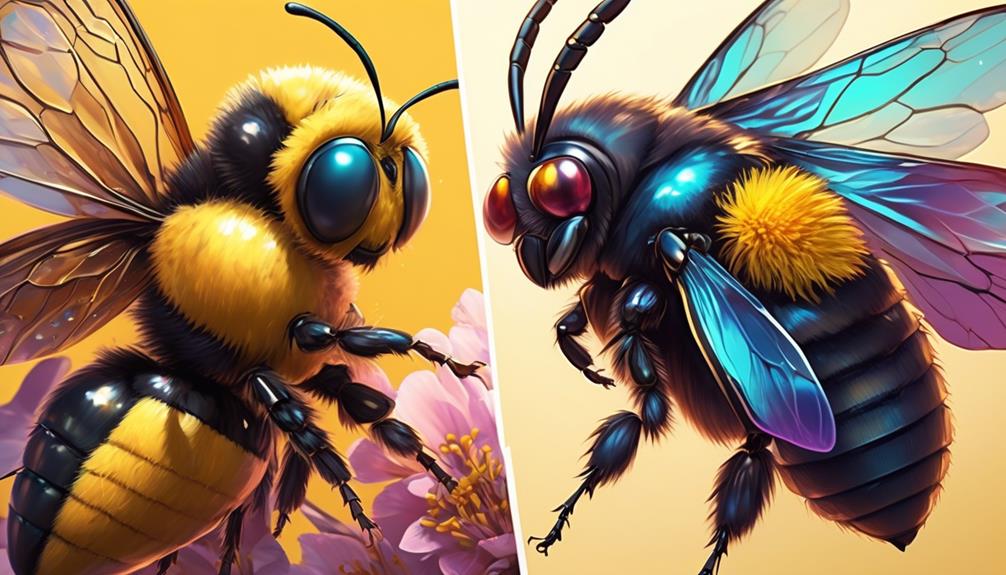
Now that you're familiar with bumblebees, let's delve into the physical attributes that distinguish these buzzing creatures from carpenter bees. Although similar in size and shape, the two species exhibit distinct characteristics that make them easily identifiable to the trained eye.
Feature | Bumblebee | Carpenter Bee |
|---|---|---|
Body Hair | Covered in dense hair | Bare, shiny abdomen |
Color | Black and yellow bands | Black, sometimes with yellow spots |
Size | Up to 1 inch | 0.5 to 1 inch |
Bumblebees are covered in dense hair, giving them a fuzzy appearance. This hair spans their entire body, including the abdomen. Their black and yellow bands are also a characteristic trait. Carpenter bees, on the other hand, pose a stark contrast with their minimal body hair. Their abdomen is bare, giving it a shiny, black appearance. Although they can sometimes have yellow spots on their back, they generally lack the vivid colouring of bumblebees.
When it comes to size, both species can reach up to one inch in length. However, carpenter bees can also be as small as half an inch, making them slightly more variable in size. By understanding these differences, you can accurately distinguish between the two species.
Behavioral Contrasts Explored
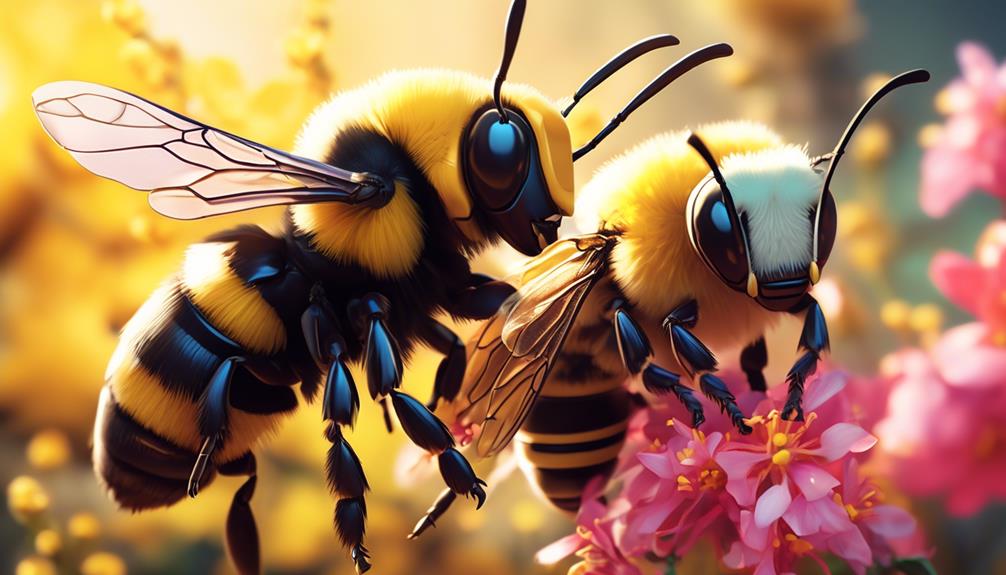
Beyond their physical differences, you'll find that carpenter bees and bumblebees also display contrasting behaviors that can help you further distinguish between these two species.
Carpenter bees are solitary insects. In contrast, bumblebees are social and live in colonies. Unlike bumblebees, carpenter bees don't produce honey or beeswax, and their females, rather than drones, are responsible for gathering nectar and pollen. Carpenter bees are known for their wood-boring behavior, carving tunnels in timber to lay their eggs, while bumblebees make their nests underground, often in abandoned rodent holes.
One distinct behavior of carpenter bees is their territoriality. Males don't sting but are extremely aggressive in defending their territory. On the other hand, bumblebees are relatively docile unless provoked.
Carpenter bees are more likely to be seen hovering around buildings, decks, and other wooden structures, while bumblebees are often found near flowers, as they're known for their robust pollinating abilities.
Observing these behavioral contrasts can provide valuable insights when trying to differentiate between carpenter bees and bumblebees. Understanding these differences can also aid in pest management strategies, should you encounter these insects in your environment.
Implications for Your Garden
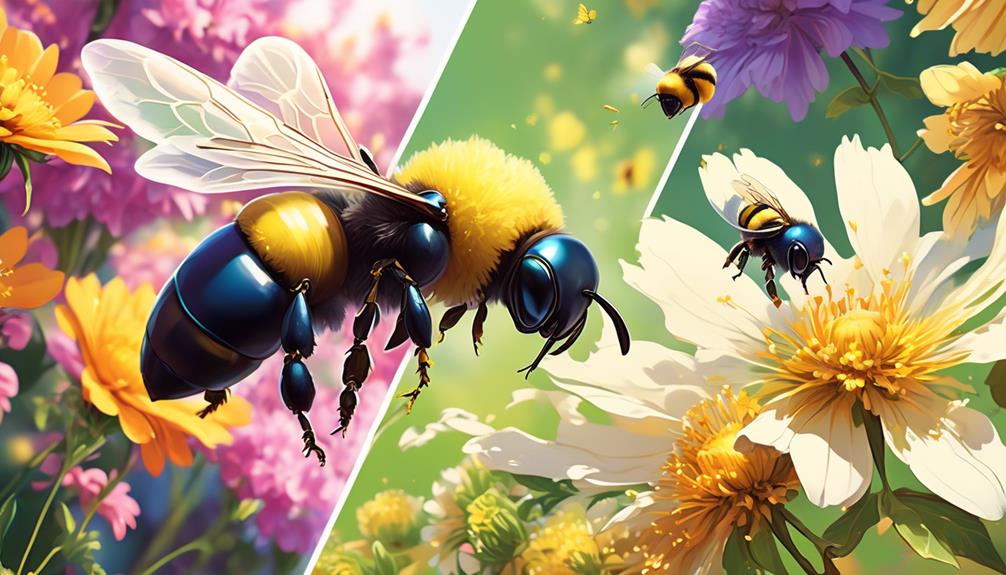
Given the distinct behaviors of carpenter bees and bumblebees, it's crucial to understand their potential impact on your garden. Carpenter bees, unlike their bumblebee counterparts, tend to bore into wood structures, potentially damaging your garden infrastructure. On the other hand, bumblebees, being prolific pollinators, could boost your plant growth.
Here's a table to better illustrate their impacts:
Impact | Carpenter Bees | Bumblebees |
|---|---|---|
Pollination | Moderate | High |
Damage to Structures | High | Low |
Attraction to Flowers | High | High |
Insecticide Resistance | Moderate | High |
Nuisance Level | High | Moderate |
While both species are attracted to flowering plants, the potential harm carpenter bees can inflict on your wooden structures can't be ignored. However, their pollination efforts, albeit less than bumblebees, are still valuable. You'll need to balance these factors when considering bee management in your garden. Bumblebees, on the other hand, pose less of a threat to your structures and provide high levels of pollination. Nonetheless, they're more resistant to insecticides, which could be a factor if pest control becomes necessary.
Conclusion
In conclusion, while you may initially confuse carpenter bees with bumblebees, keen observation reveals distinct differences.
Physically, carpenter bees boast a smoother, shinier abdomen, while bumblebees are more uniformly fuzzy.
Behaviorally, carpenter bees are solitary, unlike social bumblebees.
Understanding these distinctions can help manage your garden's health, as bumblebees are crucial pollinators, whereas carpenter bees can cause structural damage.
Therefore, identifying the correct bee species is vital.

